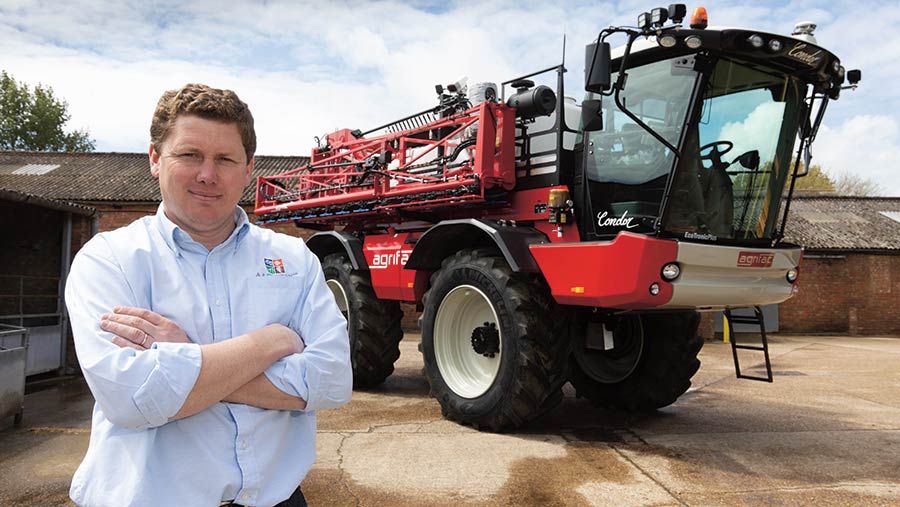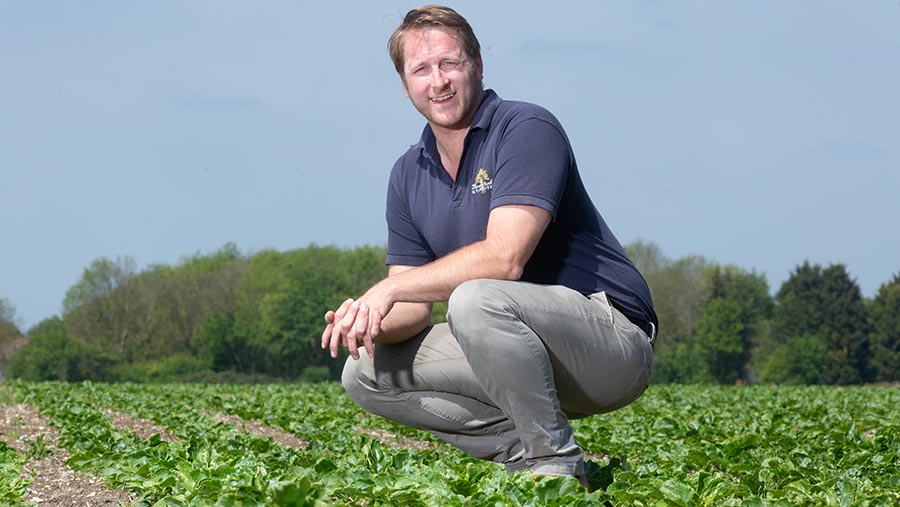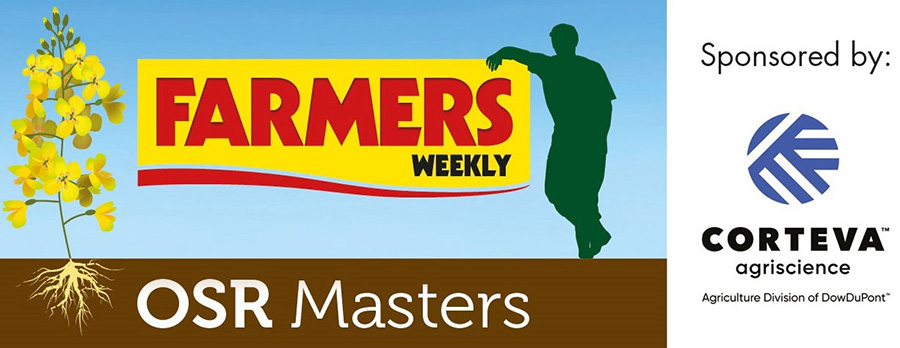OSR Masters: Oilseed rape growers plan a strategy for this season
 © Tim Scrivener
© Tim Scrivener Oilseed rape has given many growers a rollercoaster ride this year.
As it comes under renewed scrutiny, we find out how our three new Oilseed Rape Masters are managing the risks and what the future holds for the crop.
Alan Clifton-Holt, AA Clifton, Romney Marsh, Kent

Alan Clifton © Tim Scrivener
Despite success in last year’s Yield Enhancement Network (YEN) oilseed rape yield competition, run by crop consultants Adas, Kent grower Alan Clifton-Holt is not resting on his laurels.
Having achieved a yield of 6.2t/ha and scooping the Silver Award in 2018, he is now putting some of the lessons from that achievement into practice – along with insight gleaned from his involvement in Adama’s thought leadership group.
For his 313ha of oilseed rape this year, that means considering different varieties, tweaking nutrition and investigating biostimulants, as he works with Agrii agronomist Neil Harper to get the best returns.
Fine-tuning is an approach that fits in well with his overall aim to keep improving performance on the 1,500ha farm.
As well as using the YEN initiative to further their knowledge, the team try different things and make use of local trials data.
See also: OSR Masters: How an OSR grower has adapted production in a tricky year
Variety choice
Mr Clifton-Holt is growing both conventional and Clearfield varieties, with the oilseed rape crop featuring once in every six years.
Elgar, Django and Campus are the current conventional choices and two blocks of the Clearfield variety Veritas are grown where charlock is an issue.
“We’ve grown an area of Clearfield for three years. We haven’t seen a yield disadvantage at all, but are still learning how to grow it well,” says Mr Clifton-Holt.
The decision to move to home-saved seed where possible has relegated other hybrids from the line-up for the time being, although he remains open-minded about their future place.
Oilseed rape drilling takes place at the end of August and into September, with very little drilled before the August bank holiday.
“Moisture availability is the key. Even though we only have very low flea beetle numbers on Romney Marsh, we have to get it growing straight away,” he says.
Establishment system
High seed rates of about 4kg/ha are used, without a seed treatment.
Mr Clifton-Holt’s establishment system of subsoiling, followed by disc tilling to produce a fine tilth and then tine drilling has worked well for the past few years, giving consistent results.
A polymer-coated starter fertiliser is used at drilling, supplying nitrogen, phosphate and boron, which helps to get the crop up and away.
In general, nutrition is being pushed this year, to keep the crop greener for longer and to extend the flowering period.
“That was one of the key learnings from YEN. So we’re using 240kg/ha of nitrogen and 80kg/ha of sulphur, as well as providing micronutrients throughout the season,” he adds.
Having used a berseem clover companion crop in the past, he has now abandoned that practice in favour of getting better weed control.
Slug pellets are only used if needed, so are not applied right behind the drill.
“We will double roll if we can, which seems to be just as effective. Although slugs aren’t a major issue here, their numbers have risen with the introduction of cover crops,” he says.
Weed control
Herbicide use depends on the field and the weed pressure. Clearfield varieties usually have a pre-emergence treatment of straight metazachlor, followed by either Clerando (imazamox + metazachlor) or Cleravo (imazamox + quinmerac).
The rest of the oilseed rape waits until the post-emergence timing for Astrokerb (propyzamide + aminopyralid), when Mr Clifton-Holt is confident establishment has been successful.
For blackgrass, two graminicides may be required, with a cheaper product going on before a later hit with Centurion Max (clethodim).
Otherwise, he uses one prothioconazole-based fungicide in the autumn, when the crop also receives magnesium and boron.
That is followed by a plant growth regulator/fungicide combination in the spring and then one flowering spray. Insecticides are seldom used.
Biostimulants supplied by Yara are being put through their paces in 2019, to see if they have a benefit.
Applied in early March and again in April, Mr Clifton-Holt is reserving judgement until he sees the harvest results.
Steve Klenk, Garnstone Farms, Kings Pyon, Herefordshire

Steven Klenk © Tim Scrivener
Changes are being made to the way that oilseed rape is grown at Garnstone Farms in Herefordshire.
Farm manager Steve Klenk’s strategy of focusing on soil biology and introducing more diversity is widening the rotation and allowing him to reduce the farm’s reliance on inputs.
A new drill, the use of different companion crops and a rethink on varieties are all on the cards for this autumn, as he balances oilseed rape production with continually improving soil health.
With 100ha of oilseed rape currently in the ground, farm policy to date has been to grow oilseed rape no more than once every five years, as part of a flexible rotation that includes wheat, maize, herbage seed and wholecrop cereals.
Mr Klenk now has plans to extend that to seven years, in a bid to further reduce any pest and disease issues and help build soil fungi numbers.
Move to no-till
To encourage life in the soil, he has moved to no-till where conditions are suitable, included cover crops in the rotation and made best use of a combination of organic manures.
As a result, profitability is increasing and crops are performing better. Oilseed rape yields are about 4.5t/ha, with a longer rotation being key to maintaining these.
This year he is growing hybrids Aquila and Windozz alongside conventional Elgar – all chosen for their local performance.
Drilled in the first week of September, with 5t/ha of chicken litter used as a starter fertiliser, they were established with a Weaving drill following a very light cultivation.
He adds that the light cultivation with a spring tine is very important as he is planting oilseed rape very shallow. In four of his rapeseed fields, red clover was drilled at the same time.
“The idea behind it is that oilseed rape has no synergy with soil fungi. Having the clover there helps to keep the fungi going, for the benefit of the rest of the rotation,” says Mr Klenk.
Red clover
In one of those fields, where an autumn herbicide wasn’t required, the red clover is still going strong, he reports.
“I’m tempted to drill the following wheat crop straight into it. I’m also thinking about trying other crops to drill with the oilseed rape this autumn, such as lucerne and white clover,” he adds.
For 2019-20, he intends to move away from hybrids and use cleaned, home-saved Elgar seed with no dressing.
A new 6m Sly Boss drill will be used to establish the crop, using the same angled disc coulter principle as his previous system, with minimal soil disturbance.
“We usually start drilling at the end of August. If we go earlier than that, the crop gets too advanced,” Mr Klenk says.
He is also wondering about growing a blend of varieties in the same field, to increase the crop’s resilience – something that he will be trying in his winter wheat.
Grassweed control
For weed control, a metazachlor-based pre-emergence herbicide mix at about £25/ha is standard practice, followed by a late autumn application of propyzamide for grassweeds.
“Bromes are as much of a problem as blackgrass and herbage seed production means ryegrass is in the rotation. Oilseed rape is a good opportunity for blackgrass control,” he says.
One autumn fungicide is used in most seasons. In keeping with his soil health policy, every nitrogen application made to the crop includes humic+fulvic acid for beneficial soil microbes, plus molasses.
“The idea behind that is to make nitrogen use more efficient, so it pays for itself,” Mr Klenk adds.
Two sclerotinia sprays are always required, as the area is a known hotspot for the disease.
The second has 20 litres of a long-chain polymer nitrogen product included, as late nitrogen has been shown to benefit yield.
Insecticides use is down, stresses Mr Klenk. “We don’t have to spray for cabbage stem flea beetle and would prefer not to use them at other times of year.”
Edd Banks, Thomas Banks & Partners, Harlton, Cambridgeshire

Edd Banks © Tim Scrivener
The oilseed rape being grown by Edd Banks in Cambridgeshire this year only covers one-third of the originally intended crop area.
A change in drilling date – forced on him by last summer’s heatwave – saw the crop going into the ground in early September – some six weeks later than planned.
As a result, it was at the mercy of both drought and flea beetle, in a difficult season. Two of the three crop blocks failed, with those on heavy land struggling to grow away without sufficient moisture.
“It was dry until November. The plants were small and vulnerable to pest attack. I called time on one block at the end of September and the other in November. It was a common sight in this area.” says Mr Banks.
Oilseed rape drilling
His usual procedure is to drill oilseed rape from mid-July onwards, following winter barley.
Having removed the straw, he cultivates, drills and rolls in one day, applying 30kg/ha of nitrogen at the same time and some slug pellets.
“It’s a low-cost establishment system using home-saved seed, which allows us to manage the risk and avoid spending on the crop too soon,” he says.
“Drilling in July also means that by the time the flea beetles arrive in late August, the plants are already a good size and can withstand the attack. Unfortunately, the Sahara-like conditions put a stop to that this year,” adds Mr Banks.
Both of the failed blocks have been replaced with sugar beet, which is growing well and will be lifted in good time in the autumn.
His prompt decision to give up on the oilseed rape allowed him to get the sugar beet cultivations done in the autumn, rather than risk losing soil moisture in the spring.
“Being on a three-year contract with British Sugar meant sugar beet was the obvious replacement,” he adds.
Lighter land
On some of the farm’s lighter land, his remaining 40ha of oilseed rape – which is all conventional variety Campus – has fared better.
While it did need to be sprayed for flea beetle in the autumn, it doesn’t appear to have a larvae problem.
Weed control was done post emergence, with Belkar (halauxifen-methyl + picloram) used for broad-leaved weed control in October and grassweeds getting a graminicide at the same time, followed by Astrokerb in late November to target thistles and blackgrass.
“The farm is getting much cleaner where blackgrass is concerned, but a patchy oilseed rape crop can be a setback. That was another factor in the decision to replace the two failed blocks,” Mr Banks says.
Otherwise, disease control has been prothioconazole-based, with an autumn and spring application being made – the latter including some tebuconazole. A single flowering spray was applied in mid-May.
Early drilling
Looking ahead, Mr Banks is planning to grow 150ha of oilseed rape on his 1,100ha next year, going back to his preferred early drilling in July with home-saved Campus seed.
The farm’s one-pass establishment system will cost £50-£60/ha.
“Given the crop challenges, I can’t justify the cost of hybrid seed. The issue is that it’s external factors that dictate whether the crop succeeds, not the plant genetics,” he says.
Mr Banks believes that oilseed rape is still the best broad-acre break crop for the farm, providing it gets away well at establishment.
“Pulse crops are badly affected by drought, haven’t been consistent and can cause blackgrass problems. Linseed doesn’t really stack up and the jury is still out on soya,” he adds.
Sugar beet, which has come to his rescue this year, can’t be grown as frequently as oilseed rape, but still offers good returns.
“It’s another crop which has lost the use of neonicotinoid seed treatments, so we will have to be vigilant,” he adds.
Sponsor’s message
Corteva Agriscience is delighted once again to be official sponsor of OSR Masters in 2019.

Corteva Agriscience has a rich tradition of oilseed rape innovation through its heritage companies, Dow AgroSciences, DuPont Crop Protection and Pioneer Seeds.
By inviting ideas from a wide variety of sources and with our own tradition of proven oilseed rape products – such as Astrokerb, Kerb Flo 500 and PT256, combined with a rich pipeline of breakthrough products such as the soon to be launched Belkar herbicide and the first Clearfield variety on the Recommended List, PT279CL – Corteva Agriscience believes UK oilseed rape growers will meet short-term challenges and see great potential in the oilseed rape crop going forward.
Thanks to Corteva Agriscience for its sponsorship, which enables us to run OSR Masters. Farmers Weekly had full editorial control of this report.
Farmers Weekly had full editorial control of this report.

